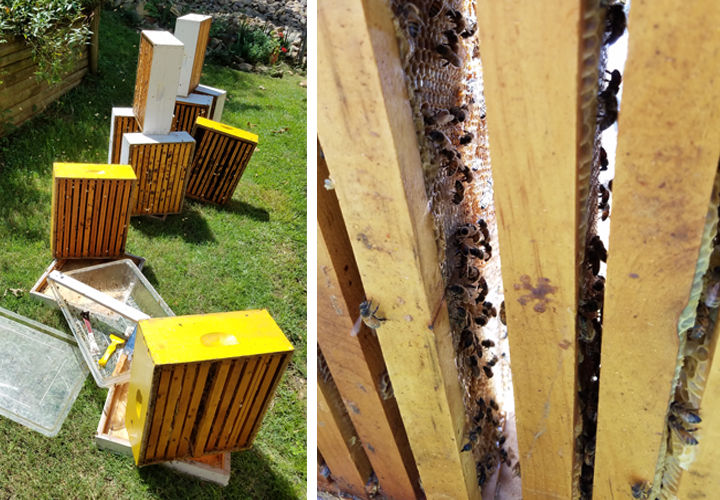
Uncapping Your Honey
Honey bees collect nectar and transform it into honey. This amazing process involves some enzymatic food processing and the removal of a lot of moisture. The bees cap off the honey comb cells with a wax lid to prevent it from reabsorbing humidity from the air. When beekeepers are ready to harvest the honey, the must "uncap" the cells.
There are many tools available to uncap honey. Some beekeepers use an electric hot knife for this job. It has a heating element in the blade, and may even be equipped with
a thermostat. Ideally the knife blade stays just the right temperature to effortlessly
melt through the beeswax cappings. When not using a hot knife, the blade should be
immediately wiped clean, or it should rest in a shallow pan of water to keep honey
from burning and caramelizing on the blade. They work fine, but they are are no better
than a traditional cold knife (pictured above) in skilled hands. A cold knife costs
considerably less, doesn't burn, and doesn't have a cumbersome cord to get in your
way.
While a good bread knife can do the trick, the beekeeper's cold knife has a few improved features. The blade is sharp and serrated, and features a slight bend at the tip. This allows the knife blade to rest flat against the bottom bar of the frame, while the tip can glide along just below the level of the top bar, which is fatter than the bottom. You can worl either up or down the frame, depending on which is more comfortable, but don't apply too much vertical pressure. Rather, make quick, gentle sawing motions, and the knife will glide effortlessly through the wax. You only want to remove the cappings -- go skin deep, don't slice it to the bone!
The cappings, and any spilled honey, drop into an uncapping tank. This will allow the cappings to drain, and the honey can be recovered. The cappings will later be rinsed and rendered to make candles, soaps, cosmetics or simply blocks of high quality beeswax.
Uncapped frames are spun in an extractor, using centrifugal force to separate the honey from the wax, and allowing the beekeeper to re-use the combs again next season. When combs are kept in good condition and given back to the bees, they will repair any minor damage, and refill them with honey. Not having to make more beeswax combs means they can store more surplus honey for themselves and for the beekeeper to harvest.

When all the frames have been harvested, and everything in the house is sticky with
honey, the bees will be eager to pitch in and help clean up. Simply bring all the
empty honey supers outside and stand them up on end in a sunny spot. Within a few
minutes bees will find them, report back to their hive mates, and begin to cover all
the combs. They will lick up any remaining honey and take it back to their hives,
so nothing is wasted. Place all your containers and tools outside as well. Keep
your stack of sticky equipment at least 25 feet from your bee hives, so you don't
trigger robbing behavior by exciting lots of bees with free honey just outside the
front door of one of your hives. Once the cappings have drained, your bees will enjoy
helping to clean up that pile of wax before you melt it down.